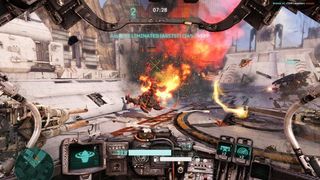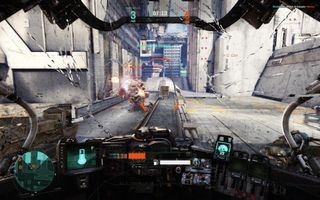Hawken on Steam: examining the state of the game after two years of new mechs and balance changes

Ever since its open beta began in December 2012, Hawken's basics have been easy to pick up. Big, stompy robots shoot and scoot with agile dodges. The modes are a slice from the same shooter pie everyone's familiar with, and it's a snap to load up and jump into a team deathmatch in less than a minute. Maps paint worlds of well-worn neon-lit cityscapes and desolate badlands. Hawken is like the mohawked, studded-jacket-wearing punk brother of MechWarrior Online: a youngster with a brash streak, but definitely its own brand of cool .
Hawken's also growing up. It transitioned to Steam last month , moving away from a dedicated launcher and enticing new recruits with an Early Access initiative and a couple purchasable bonus packages. Now it's once again fully Free to Play . Two years of patches and adjustments have streamlined Hawken and stripped away unused features, making it easier to get into than ever. After two weeks of playing Hawken on Steam, I'm still skeptical of its F2P monetization, but faster-paced combat reminiscent of Quake and new mech classes kept me coming back for more.
Mecha-groove
Maneuvering your mech into a superior position against an enemy is all about boost-assisted side-strafing. Those moves are now easier to pull off. Strafing on the ground doesn't consume fuel any longer, so I had extra juice for longer sprint burns and higher hovers for some death from above. I'm glad for the extra flexibility, and the change simplifies fuel conservation while simultaneously keeping Hawken's dodge-or-die dogma intact.
Spotting important information quickly from the cockpit still takes some effort. I could easily discern health, fuel, and ability status via large, friendly rectangles stretched across the bottom of my screen, but taking a read on the enemy wasn't so simple. Red names and enemy health often dim and smudge against the backdrop of industrial grime and metal guts flying everywhere, especially with motion blur and PhysX effects cranked to max. Determining successful shots with hit-markers was tough in the thick of it all. Hawken could use opacity/contrast options for brightening up crosshairs and text.

A costly war
Bringing new mechs into the garage works a little differently now. Previously, ranking up would unlock additional mechs at certain thresholds, particularly after achieving the rank cap for an active mech. That's been replaced with an unabashed redirect to microtransactions and spending Hawken Credits—currency earned by playing matches—and Meteor Credits bought with real moneydollars.
This is where Hawken's F2P element complicate the sense of progression. I'm urged to get into the grind with tantalizing mech and item previews, but I'll need to either gather enough HC playing with an undergeared disadvantage or take a shortcut to what I want with MC. Crushing the enemy team and scoring high points gets me around 170 HC per match, so dedicated players can cash in for a new mech within a couple days or so.
I get Adhesive's need to pull revenue from an in-game economy. My concern stems from a different kind of cost: personalization. The tuning system from Hawken's earlier versions is gone. The only measure of stat adjustment for my bot comes from equipping internal components with both positive and negative changes to armor, damage, and heat rate. I can certainly swap my primary and secondary weapons for a different set, but the guns I can use are available for most mechs.
The biggest gaming news, reviews and hardware deals
Keep up to date with the most important stories and the best deals, as picked by the PC Gamer team.
To top it off, items and internals are unlocked for only one mech at a time, and I soon found myself returning to Hawken's shop to resupply frequently. It's a shame the system is set up this way—I wasn't particularly happy having my completionist streak punished by multiple rounds of item grinding simply to kit out my available mechs.
There's upsides to all of this, though. With tuning gone, gear disparity between beginners and veterans is much more even. Armor values for every mech have been halved—in other words, fights are shorter and faster. Death comes swiftly. Tanky-type mechs such as the Brawler and Rocketeer can't soak up as much damage as they used to, but the tradeoff is worth it: bursting an enemy from 100 to 0 in less time it takes to blink is a real possibility, and that's a pleasing nod to old-school frag-fests like Unreal Tournament or Quake.

New treads
Adhesive have kept to a strong focus on furnishing extra content for Hawken, adding more mechs with specialized playstyles.
The Technician is a roving med-bot that sticks a repair beam onto nearby allies while debuffing enemies for increased attack damage. Played right, it's an asset for any team, since getting healed by a Technician saves the trouble of switching to defenseless self-repair mode. I enjoyed scrambling with my teammates to scrap a spotted Technician—their value on the field makes them clanking bullseyes—and piloting one while buddied up with a guardian is a great alternative for beginners who don't want to use the starter CR-T mech.
The Predator is like Team Fortress 2's Spy. Instead of a classy suit, it sports a sleek chassis, and instead of a knife, it sticks a railgun up someone's exhaust vents. It can cloak, masking its presence from radar and making it difficult to see. It excels at picking off weakened targets from mid-range and getting extra close for ambushes, but like its cigarette-twirling counterpart, it quickly crumples under fire.
The Incinerator is the newest mech on the line and perhaps the most interesting. It absorbs heat generated from its primary minigun weapon to expend it all in fiery explosions or lob fireball grenades. I found the Incinerator best for steady pressure—transferring heat to damage means holding down the triggers as long as possible, and the endless flow of fire is great for weakening enemies for my teammates to finish off.
The new blood(oil?) fits in well with Hawken's previous robo-roster. Concentrating on repair and area denial add a few extra layers of team cohesion, but players aren't punished if they just want to flame in and stick to bullet smackdowns. That degree of choice is pretty excellent for a F2P game, and I'm glad to see such flexibility show up more often outside of Team Fortress 2.
Four new maps have also shown up throughout Hawken's beta period. Front Line is a symmetrical and spacier arena housing both open areas for sharpshooters to prey upon and clumps of grimy industrial structures reminiscent of Prosk's cyberpunk theme. Facility is a dusty mining platform of ramps, jump pads, and tight corridors with plenty of blind corners and an elevated peak with a commanding view of the arena. Last Eco is a dense circular patch of jungle that makes it tough to spot enemy outlines. Wreckage boasts frenetic close-quarters fights in the rusted remains of a crashed starship.

Steeling time
In its newer form, Hawken is a potent exercise of how well you've refined your shooter skills. Adhesive's changes have homogenized what you're given access to, but how you handle your mech in battle now boils down to quick reactions and precise aim instead of throwing the dice against encountering overpowered item and weapon builds.
The F2P model still needs tuning. Hawken hasn't quite stumbled into the pay-to-win pitfall, but the limited benefits from spending hard-earned HC or MC—at least let custom paint items apply to all my stabled mechs, for goodness sake—means you'll definitely hit that “Market” button more than once. The starter mech is more than brawny enough to jump into the fray as any other class type, but be prepared to spend hours playing to unlock new toys.
Still, Hawken rocks big time during actual combat, and I'd recommend at least trying out a couple offline practice rounds with AI-controlled enemies to get started. If you want to experience the competitive side of Hawken, you can do so without spending a single microtransactional cent. The true price is measured in time, but for what Hawken offers—steep unlock grind and all—is well worth the hours you sink into it.
Omri Petitte is a former PC Gamer associate editor and long-time freelance writer covering news and reviews. If you spot his name, it probably means you're reading about some kind of first-person shooter. Why yes, he would like to talk to you about Battlefield. Do you have a few days?
Most Popular





